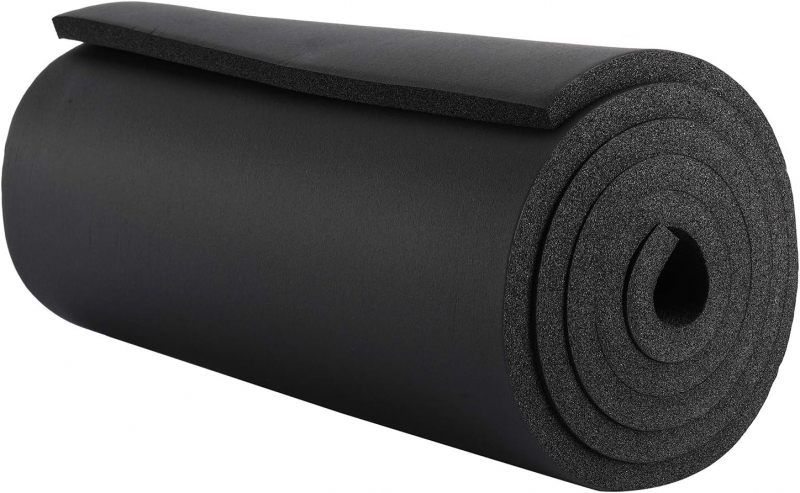EPDM foam (Ethylene Propylene Diene Monomer foam) is far more than just a rubber material. Its unique combination of properties makes it an indispensable engineered solution across countless industries.
EPDM foam (Ethylene Propylene Diene Monomer foam) is far more than just a rubber material. Its unique combination of properties makes it an indispensable engineered solution across countless industries. Understanding its key applications and the driving market forces is crucial for engineers, designers, and procurement specialists seeking reliable performance. Let's delve into the world where EPDM foam excels.
What Makes EPDM Foam Special?
Before exploring its uses, it's vital to understand its core strengths:
· Exceptional Weather & UV Resistance: Defies degradation from sunlight, ozone, rain, snow, and extreme temperatures (-50°C to +150°C / -60°F to +300°F).
· Superior Sealing & Compression Set: Maintains its shape and sealing force over time, even under constant compression.
· Excellent Water & Moisture Resistance: Closed-cell structure acts as an effective barrier against liquids and vapor.
· Good Thermal & Acoustic Insulation: Reduces heat transfer and dampens sound effectively.
· Chemical Resistance: Withstands many polar solvents, water-based chemicals, alkalis, and acids.
· Flexibility & Resilience: Conforms well to irregular surfaces and recovers after deformation.
· Durability & Long Service Life: Offers outstanding resistance to aging and environmental stress cracking.
Key Applications of EPDM Foam
These properties translate into widespread utility:
1. Automotive Industry (Major Consumer):
o Door & Trunk Seals: Primary sealing against water, dust, wind, and noise.
o Window Seals & Encapsulation: Ensuring smooth operation and weatherproofing.
o Hood & Hatch Seals: Protecting engine bays and cargo areas.
o HVAC System Gaskets: Sealing ductwork and housings.
o Vibration Damping Pads: Reducing noise and harshness (NVH).
o Battery Pack Seals (EVs): Crucial for thermal management and environmental protection.
2. Construction & Building Envelope:
o Window & Door Perimeter Seals: Essential for energy efficiency (preventing air/water leaks).
o Curtain Wall Gaskets: Sealing joints in high-rise facades.
o Expansion Joint Fillers: Accommodating building movement while sealing.
o Roofing & Flashing Seals: Protecting vulnerable junctions from water ingress.
o Pipe Penetration Seals: Sealing around pipes entering buildings.
3. HVAC & Refrigeration:
o Ductwork Seals & Gaskets: Preventing air leakage in heating/cooling systems.
o Panel & Cabinet Seals: On air handlers, chillers, and refrigeration units.
o Insulation for Pipes & Fittings: Preventing condensation and heat gain/loss.
o Vibration Isolation Pads: Under compressors and fans.
4. Electrical & Electronics:
o Enclosure Gaskets (IP Ratings): Providing dust and water ingress protection (IP54, IP66, IP67).
o Cable Entry Seals: Securing and sealing cables passing through panels.
o Vibration Damping for Sensitive Equipment: Protecting components.
o Insulating Spacers & Pads.
5. Industrial Machinery & Equipment:
o Access Panel & Hatch Seals: On control cabinets, machinery guards, enclosures.
o Vibration Isolation Mounts: Reducing noise and protecting machinery.
o Conveyor System Seals & Wipers.
o Gaskets for Fluid Handling Systems: Resisting specific chemicals.
6. Renewable Energy:
o Solar Panel Frame Seals & Mounting Pads: Weatherproofing and vibration isolation.
o Battery Storage Enclosure Seals: Similar demands to automotive EVs.
o Wind Turbine Nacelle & Hub Seals.
EPDM Foam Market Dynamics & Drivers
The global EPDM foam market is experiencing steady growth, driven by several key factors:
· Automotive Production & Electrification: Rising global vehicle output, especially EVs requiring extensive sealing for batteries and sensitive electronics, is a primary driver. Demand for quieter cabins also boosts usage.
· Construction Boom & Energy Efficiency Regulations: Stricter building codes worldwide mandating better insulation and reduced air leakage (e.g., LEED, BREEAM, Passive House standards) fuel demand for high-performance sealing solutions in windows, doors, and facades.
· HVAC Industry Growth: Increasing urbanization, climate control needs in hotter regions, and demand for energy-efficient systems drive HVAC equipment production, directly increasing EPDM foam usage.
· Industrial Automation & Electronics Proliferation: Growth in manufacturing, data centers, and consumer electronics increases demand for protective enclosures and reliable gasketing solutions.
· Renewable Energy Expansion: The rapid growth of solar and wind power installations creates significant demand for durable, weather-resistant sealing components.
· Replacement Demand: The long but finite lifespan of EPDM foam seals in existing vehicles, buildings, and infrastructure creates a continuous aftermarket need.
· Performance Advantages: Increasing recognition of EPDM foam's superior durability and weather resistance over alternatives like PVC or CR foam in critical applications.
Regional Markets: Demand is strong globally, with significant production and consumption in:
· Asia-Pacific: Dominant market, driven by massive automotive production (China, Japan, S. Korea, India) and construction activity (China, SE Asia).
· North America: Mature but growing market, fueled by automotive (especially EV), construction retrofits, and HVAC.
· Europe: Strong demand from automotive (Germany, France, Italy), stringent construction regulations, and renewable energy focus.
· Rest of World: Growing industrial and construction sectors driving demand in regions like South America and the Middle East.
Conclusion: The Enduring Value of EPDM Foam
EPDM foam is a material engineered for resilience. Its unparalleled combination of weather resistance, sealing performance, thermal and acoustic properties, and durability ensures it remains a critical component in industries demanding long-term reliability and protection against the elements. From the car you drive and the building you work in, to the renewable energy powering your home, EPDM foam plays a vital, often unseen, role. As markets push for greater efficiency, electrification, and sustainability, the demand for this versatile, high-performance material is poised for continued growth.


